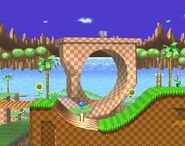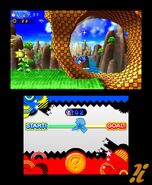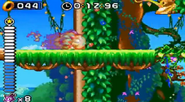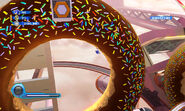Regular giant loop as it is seen at Green Hill in Sonic Generations.
Shuttle loops, also called giant loops,[1] loop-de-loops[2] or just loops, are common gameplay elements seen in almost every game in the Sonic the Hedgehog series, which are seen in numerous places around the world of Sonic the Hedgehog. Shuttle loops are different-sized landforms of unknown origin in the zone's or stage's scenery, that have a hole of loop-de-loop which the playable character can run through as a part of the path. Shuttle loops usually appear in numerous different versions crafted out of the landscape, though there are also shuttle loops in industrial, futuristic or urban-type of levels as well.
Shuttle loops have been introduced in the original 16-bit version of Sonic the Hedgehog. Besides having appeared in the games on countless occasions, Shuttle Loops have also made numerous appearances in other media.
Overview

Concept art from earlier development of original Sonic the Hedgehog, that shows the functionality of shuttle loop.
In Sonic the Hedgehog series, shuttle loops are seen in almost every platform title and even in some spin-off games. While not every level of each game have shuttle loops, they are seen to be one of the most common elements in the series. The earlier games for Sega Genesis featured more developed game engine with momentum-based physics than any video game before.
In order to pass through a shuttle loop, a player must move at sufficient speeds in order to remain in contact with the surface of the loop, and will then exit on the other side. If a playable character is not moving fast enough, the playable character will fall down out of the loop, or not be able to scale the slopes. When moving through a shuttle loop, the player is able to either run or roll, if moving fast enough, through it. Also, similar to the real-life phenomenon of moving downhills, the shuttle loop can give the playable character more momentum should the player perform Spin Attack while moving through loop-de-loop. Numerous shuttle loops can also be differently formed with longer loop-de-loops, which requires more momentum on the player behald to be gained, before the player can get through it.
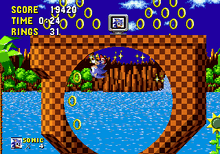
Sonic moving around the loop in Sonic the Hedgehog (1991). Notice group of Rings and extra life monitor above it.
Most of the time, shuttle loops have a certain amount of Rings set up in line on their loop-de-loops, which the player can collect by moving through them. Shuttle loops have flat platforms above the loop-de-loop that the player can stand on. On such platforms, there can usually be found a huge amount of Rings, Item Boxes with different power-ups or objects to be used, and even alternate pathways that the player can access. Because the player cannot reach the flat tops of the shuttle loops by jumping, there are always moving platforms nearby the shuttle loops that can take the player to the top of them. In numerous games, however, the shuttle loops do not have platforms above it to move on or are part of the ceiling of the level. Also, in a few games, alternate pathways can also go sideways or through the hole of loop-de-loops.
An example of the loop's start in Sonic Adventure. Dash Panels guides automatically the player through the loop.
In later games, especially 3D games, there can usually be found a Dash Panel just before a shuttle loop begins, eliminating the need for the player to gain a momentum before entering a shuttle loop. Because of this, backtracking in the levels of the 3D games can be hard, if not impossible. Games such as Sonic 3D Blast and Sonic Chronicles: The Dark Brotherhood have automatic sections of the shuttle loops where the playable character goes through them to another section of the level without the player having to control to the character. In Sonic Runners, the playable character has to automatically perform Spin Attack in order to pass through Loops to collect Rings or the player moves over past it instead.
List of shuttle loop types
|
Picture |
Title | Level Examples | Description |
|---|---|---|---|

|
Regular loop | The basic type of shuttle loops that is located on a flat terrain and has walk-through platform above it with items, enemies or other stuff set there. It is also seen between ground and ceiling parts, that has no above platform on it. They are also easy to go through while backtracking in the level. At Egg Utopia in Sonic Advance 2, the player can go through these loops in upside down gravity. | |

|
Downward guiding loop | Another basic type of loops, that guide directly down to lower part of the level, but it can have small ramp to guide to the linear way. It can similarly to the regular loops to have above, walk-through platform, but it mostly can have ceiling above of it as well. These types can be hard for doing backtracking, as the player needs huge amount of speed to climb up and after that, the player has to try go through the loop-de-loop. The ones in Marble Garden Zone lead into corkscrew poles that deposit Sonic on one side or the other. The player can also jump off during this sequence to end up one a preferred side. | |

|
Downhill loop | These shuttle loops are found at downhills, which can give huge amount of speed if the player goes to rolling mode while going through of these loop-de-loops. Like previously mentioned loops, they can have or not above platforms to walk through. Though they are not as hard to backtrack through as downward guiding loops, the player still has to have enough of speed. Some games can have really steep downhills to climb back to the top. | |

|
Tall loop | These larger shuttle loops can have alternate pathways going through the hole of the loop itself. The player might be unable to get through these ones normally, but if the player is launched by a spring or dash panel, he/she would be easily move through one. Depending on the game, it can be impossible to backtrack through these loops. | |

|
Automatic pinball loop | These loops are similar to downhill loops, however they can be found most of the time from casino-themed zones and are automatic, when the player moves through of them after being launched by Pinball Shooter. If the player doesn't have enough of momentum, the playable character will roll down to the hole and try again harder. | |

|
Down tunnel leading loop |
They are mostly similar to downward guiding loops, which only lead to tunnels below the loop. In Hill Top Zone and IceCap Zone, these tunnels are blocked with breakable blocks, which the player has to destroy by performing Spin Attack on the loop. After entering to the tunnel, it will soon lead to the another place on the level. | |
| Tunnel/Pipe loop | Loops have also been done in underground tunnels or transport tubes in certain games. These sections are automatic, as the player is unable to control his/her character. In Sonic Advance 2, large and long horn instruments are seen doing loop, where the player can go through. Unable to backtrack through with these loops in any game. | ||

|
Deadlock loop | Very rare types of shuttle loops, that are only seen in Sonic the Hedgehog CD. They don't lead anywhere except back, where the player comes from. They are seen to have a small platform above part of the loop-de-loop, while the bottom part has a block in the center with springs usually being set to lead back. | |

|
Crossing loop | Only seen in Angel Island Zone act 1, where one of downhill loops crosses the two pathways together. As the one goes with normally on downhill, the another one comes from the bottom pathway and leads to the loop. | |

|
Bottom corner loop | At Ice Cap Zone act 2, these types are usually on the bottom of downward guiding loops and are oppositely disposed to walls. These loops can gain even more speed, if the player is on it's rolling mode after going through the downward guiding loops. It is impossible to backtrack through these and downward guiding loops. | |

|
Underground launcher loop | If the player enter's right pipe, launcher will automatically boost the player through the loop and shoots him to upwards, where another launcher loop might be. While they are mechanized in Launch Base Zone, in Neo Green Hill Zone they are not that much. Jumping to the upper pipe will fire the player backwards. | |

|
Tubular loop | These types are similar to many other shuttle loops. The only difference is that, while they aren't part of ceilings, they don't have any platform above them, where the player is able to walk through. In Mushroom Hill Zone, some of them can lead to falling (picture on left). In 3D games, these types have been wildly used. | |

|
Upward guiding loop | Another general types of shuttle loops, which are similar to downward guiding loops. However, these are usually located on upper part of the level, while the player has to use dash panel or spring to move fast on the wall and get through of these loops from the lower part of the level. However they are easier to backtrack through. | |

|
Multispinning loop | Another type of shuttle loops, in which When the player enter to this loop-de-loop, it will make playable character spin around automatically on the loop two or more times, until the loop ends. | |

|
Ring shooter loop | After being launched by Ring Shooter, it can sometimes do several mid-air loops, while guiding the player to the other side of the level. | |

|
Giant loop | One of types seen first time in Sonic Advance 2. Giant loops have similar things comparing to numerous other loops, while the player needs to have huge amount of speed to get through these. In Leaf Forest act 2, there's one, that has huge hole on the above part of it. There can be giant loops, that have or haven't walk through platform on the loop. They are wildly seen in 3D games. | |
| File:3 Way Loop.jpg | Giant three-way loop | One of general seen types featured in Sonic Heroes. It is basic giant loop being separated to three different ones side by side. Each of three members on the playable team use these to get power-ups from item boxes on each loop. In Sonic Generations, they lead to three different pathways, which the player can choose. | |

|
Inverse loop | These types of shuttle loops are not usually seen, as they are set below the ground. The player has gain enough of speed to swing the playable character around these loops. Sometimes set dangerously over bottomless pits. | |
| Rail loop | One of recent types of shuttle loops, which are formatted with different grind rails. They are able to go easily through by gaining huge amount speed with dash panels on grind rails. In Sonic Colors, there are also seen three grind rail loops side by side. | ||
| Long loop | These types of shuttle loops are similar to regular ones, but sligtly longer to go through. The player must have gain enough of speed to get through of these. |
Trivia
- One of the many unfixed glitches in Sonic the Hedgehog (2006) involves any of playable character in the game being able to walk, even stand on upside down at shuttle loop without falling down as it were solid ground.
- In Super Smash Bros. Brawl, a Shuttle Loop can be seen in the background of arena Green Hill Zone with Tails, Knuckles, and Silver seen running through it constantly.
- In some of the 2D side-scrolling Sonic games as the character runs on a loop, if the player inputs the character to jump while at the center of the loop, the character will actually accelerate.
See also
- Corkscrew loop
- Ramp
Gallery
| Gallery |
|---|
References
- ↑ Sonic the Hedgehog (1991) (Sega Mega Drive) North American instruction manual pg. 7.
- ↑ Sonic the Hedgehog 2 (Sega Mega Drive) North American instruction manual pg. 12.



